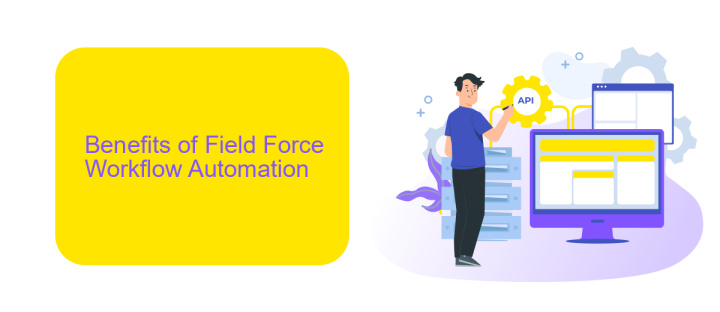Field Force Workflow Automation
In today's fast-paced business environment, efficient management of field operations is crucial for success. Field Force Workflow Automation offers a transformative solution, streamlining tasks, enhancing productivity, and ensuring seamless communication between teams. By automating routine processes, businesses can reduce errors, cut costs, and improve service delivery, ultimately driving growth and customer satisfaction.
Introduction to Field Force Workflow Automation
Field Force Workflow Automation is a transformative approach to managing and optimizing the tasks of field workers. By leveraging advanced technologies, businesses can streamline operations, reduce manual processes, and enhance productivity. This automation ensures that the right information is available at the right time, enabling field workers to perform their duties more efficiently.
- Automated task scheduling and dispatching
- Real-time data collection and reporting
- Seamless communication between field workers and headquarters
- Integration with existing systems and tools
- Enhanced customer service and satisfaction
One of the key components of successful field force workflow automation is integration. Tools like ApiX-Drive facilitate seamless integration between various systems, ensuring that data flows smoothly and tasks are synchronized across platforms. By automating these workflows, businesses can not only save time and resources but also improve the overall efficiency and effectiveness of their field operations.
Benefits of Field Force Workflow Automation

Field force workflow automation offers numerous benefits that significantly enhance operational efficiency. By automating routine tasks, field workers can focus on more critical aspects of their job, leading to increased productivity and reduced human error. Real-time data collection and reporting streamline decision-making processes, ensuring that managers have up-to-date information to make informed choices. This automation also allows for better resource allocation, ensuring that field teams are deployed where they are most needed, ultimately improving service delivery and customer satisfaction.
Another significant advantage is the seamless integration with other business systems. Tools like ApiX-Drive facilitate easy and efficient integration of various applications, ensuring that data flows smoothly between systems without manual intervention. This reduces the complexity of managing multiple platforms and enhances data accuracy. Moreover, automated workflows can be customized to meet specific business needs, offering flexibility and scalability as the organization grows. Overall, field force workflow automation not only optimizes daily operations but also provides a strategic advantage by enabling a more agile and responsive workforce.
Key Features of a Field Force Workflow Automation Solution

Field Force Workflow Automation solutions are designed to streamline and optimize the operations of field teams, enhancing productivity and efficiency. These solutions come with a variety of key features that cater to the specific needs of businesses with field operations.
- Real-Time Tracking: Monitor the location and status of field agents in real-time to ensure timely task completion and efficient route planning.
- Task Management: Assign, prioritize, and track tasks easily, ensuring that field agents are always aware of their responsibilities and deadlines.
- Data Collection: Seamlessly collect data from the field using mobile devices, which can be instantly synced with the central system for analysis and reporting.
- Integration Capabilities: Utilize services like ApiX-Drive to integrate various tools and platforms, ensuring a cohesive workflow and seamless data transfer between systems.
- Automated Reporting: Generate detailed reports automatically, providing insights into field operations and helping in decision-making processes.
Implementing a Field Force Workflow Automation solution not only boosts the efficiency of field operations but also enhances communication and coordination among team members. By leveraging these key features, businesses can achieve higher productivity and improved service delivery.
How to Implement Field Force Workflow Automation

To successfully implement Field Force Workflow Automation, start by assessing your current processes and identifying areas that can benefit from automation. This initial step is crucial for understanding the specific needs and challenges of your field force operations.
Next, choose the right tools and technologies that align with your goals. Look for solutions that offer seamless integration capabilities, such as ApiX-Drive, which can connect various applications and automate data flow between them. This ensures that your field force has real-time access to critical information, enhancing their efficiency and productivity.
- Evaluate current workflows and pinpoint automation opportunities
- Select suitable automation tools and technologies
- Integrate with existing systems using platforms like ApiX-Drive
- Train your field force on the new automated processes
- Monitor and optimize the automated workflows continuously
Finally, ensure continuous monitoring and optimization of the automated workflows. Regularly gather feedback from your field force to identify any issues or areas for improvement. By maintaining a proactive approach, you can ensure the long-term success and scalability of your Field Force Workflow Automation.
- Automate the work of an online store or landing
- Empower through integration
- Don't spend money on programmers and integrators
- Save time by automating routine tasks
Case Studies and Success Stories of Field Force Workflow Automation
One remarkable case study of Field Force Workflow Automation is from a leading telecommunications company that significantly improved its service delivery. By implementing automated workflows, they reduced the time required for field technicians to complete tasks by 30%. The integration of real-time data and automated scheduling allowed the company to respond to customer issues more swiftly, enhancing overall customer satisfaction. This transformation not only boosted productivity but also reduced operational costs, providing a clear return on investment.
Another success story comes from a utility services provider that faced challenges in coordinating field operations. Through the use of ApiX-Drive, they seamlessly integrated various software systems, enabling real-time data sharing and automated updates. This integration streamlined their workflow, reducing manual data entry errors and improving response times. The utility services provider reported a 25% increase in efficiency and a significant drop in customer complaints, showcasing the tangible benefits of Field Force Workflow Automation.
FAQ
What is Field Force Workflow Automation?
How can Field Force Workflow Automation benefit my business?
What types of tasks can be automated in field force operations?
How difficult is it to implement Field Force Workflow Automation?
What tools can I use to integrate and automate my field force workflows?
Time is the most valuable resource in today's business realities. By eliminating the routine from work processes, you will get more opportunities to implement the most daring plans and ideas. Choose – you can continue to waste time, money and nerves on inefficient solutions, or you can use ApiX-Drive, automating work processes and achieving results with minimal investment of money, effort and human resources.


